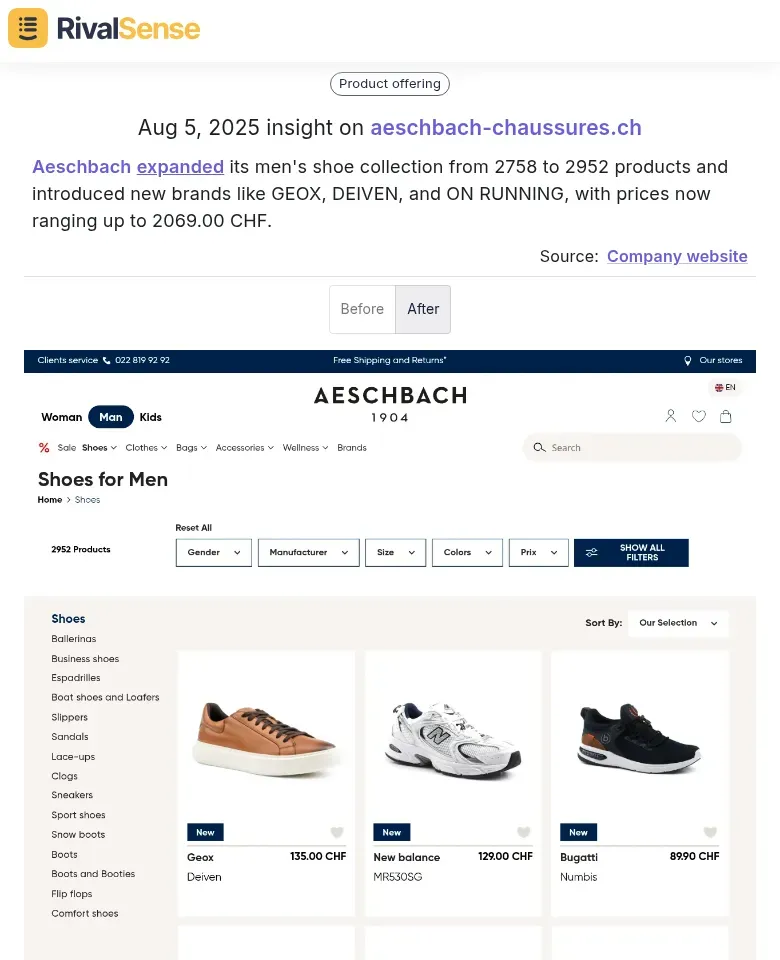How Aeschbach's Expansion Prompted Rival Strategy Shifts
Aeschbach's recent expansion into new markets has not only broadened its own horizons but also sent ripples through the competitive landscape, prompting rivals to reassess and recalibrate their strategies. This case study examines how Aeschbach's bold moves reshaped market dynamics, offering actionable insights for businesses navigating competitive shifts. Before the expansion, the market featured stable competitors with defined territories, but Aeschbach's aggressive entry into underserved regions disrupted this equilibrium.
Practical takeaways include:
- 🔍 Monitor competitor moves consistently
- 🎯 Identify gaps in your offerings
- ⚡ Prepare contingency plans for swift pivoting
Competitive Positioning Checklist:
- [ ] Assess current market standing
- [ ] Analyze emerging trends
- [ ] Develop response scenarios
Competitive Response Analysis
Following Aeschbach's expansion, key competitors like BrandX and InnovateCorp rapidly adjusted their approaches. BrandX accelerated product development cycles, while InnovateCorp diversified market presence to mitigate risk—demonstrating the critical role of agility in competitive strategy.
To analyze such strategic shifts:
- 🧩 Identify affected competitors through market share analysis
- 📢 Track public announcements and pricing changes
- ⏳ Evaluate long-term market implications
Action Framework:
- Real-Time Monitoring: Use tools like RivalSense for immediate alerts
- SWOT Analysis: Re-evaluate strengths/weaknesses post-shift
- Customer Insights: Gauge preference changes
- Scenario Planning: Prepare for multiple outcomes
💡 Pro tip: Update competitive intelligence weekly to stay ahead of trends.
RivalSense's Role in Monitoring Competitor Moves
In Aeschbach's dynamic expansion landscape, RivalSense proved invaluable for businesses needing real-time competitor insights. The platform's analytics highlighted critical trends like pricing shifts and market entries, enabling proactive strategy adjustments.
For example, RivalSense recently detected:

Aeschbach expanded its men's shoe collection from 2758 to 2952 products, introducing brands like GEOX and ON RUNNING, with prices up to 2069.00 CHF.
Tracking product expansions delivers strategic value by revealing:
- 📈 Inventory focus shifts
- 🎯 New competitive threats
- 💰 Pricing strategy adjustments
Maximize Competitive Intelligence:
- ⏰ Set real-time alerts for competitor activities
- 📊 Analyze trend dashboards
- 📌 Benchmark against rivals
- 🚀 Implement swift countermeasures
Case Study: A Client's Strategic Pivot
When Aeschbach encroached on a mid-sized SaaS provider's market, the client faced declining share and retention issues. RivalSense data revealed Aeschbach's focus on premium enterprise clients, exposing a mid-market gap.
The strategic pivot involved:
- 🔎 Market Gap Analysis: Using competitor data to identify opportunities
- 💲 Tiered Pricing: Attracting cost-sensitive customers
- 🤝 Enhanced Support: Differentiating through personalized service
Results within six months:
- ✅ 20% mid-market acquisition growth
- ✅ Improved customer satisfaction
Lessons Learned and Best Practices
Aeschbach's expansion taught competitors vital lessons about agility and intelligence-driven strategy. Continuous monitoring and adaptive planning emerged as non-negotiable for market resilience.
Best Practice Checklist:
- [ ] Leverage real-time tracking tools
- [ ] Conduct quarterly strategy reviews
- [ ] Foster cross-functional agility
- [ ] Benchmark against competitors
- [ ] Prioritize customer feedback
🔄 Update monitoring protocols weekly to maintain competitive edge.
Conclusion: The Future of Competitive Strategy
Aeschbach's case demonstrates how one player's expansion can force entire markets to evolve. Businesses integrating competitive intelligence into decision-making layers consistently outperform reactive rivals.
Key action steps:
- 🕵️♂️ Monitor competitors continuously
- 🔄 Conduct regular SWOT analyses
- 🤝 Align departments with market shifts
Final Insight: Future winners will proactively shape markets rather than just react to changes.
Ready to transform competitive intelligence into strategy? Try RivalSense for free and get your first competitor report today!
📚 Read more
👉 Master Competitor Insights: Track Roadmap Signals for Strategic Advantage
👉 Predictive Analysis in Fintech: Decoding Competitor Strategies for Market Leadership
👉 Optimizing Market Entry with Competitor Advisory Insights
👉 How to Decode Strategic Shifts Through Competitor Partnerships
👉 Practical Competitive Research: A Step-by-Step Guide for Business Leaders
